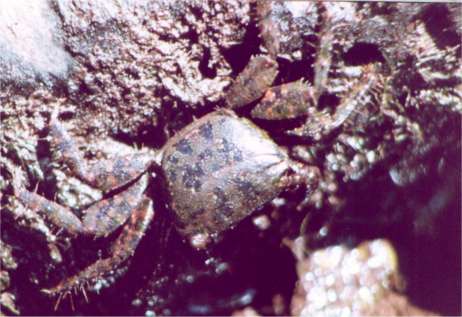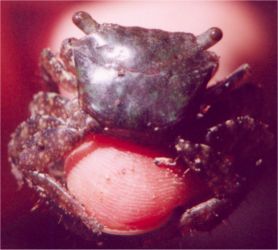|
A field guide to Kenyan
mangroves
|
Metopograpsus thukuhar (Owen, 1839)
Family: Grapsidae

Zone: Equally inhabits Rhizophora mucronata and Ceriops tagal zones (Gillikin, 2000). Also landward side of coastal mangrove belts (Hartnoll, 1975) and seaward of creek mangroves (Cannicci et al., 1999).
Habitat: Lower trunks of tress and roots - does not burrow (Vannini et al., 1997).
Food: Omnivorous (Vannini et al., 1997; Dahdouh-Guebas et al., 1999)
Ecological notes: Prefers lower parts of mangrove swamp; a very common mangrove crab species (Macnae, 1968; Gillikin, 2000). May exploit burrows of other species as temporary refuge (Vannini et al., 1997). Spends most of its time on mangrove roots (Fratini et al., 2000).
Distinguishing characteristics: Carapace and legs brownish-yellow or brownish red, variably mottled. External face of claw violet (pink in juveniles) Maximum carapace width about two times larger than posterior margin [compare with M. messor and M. oceanicus] (carapace width about 2.5 cm)
Geographical range: Japan, Tahiti and Hawaii; From the red Sea to South Africa (Vannini and Valmori, 1981).

References:
Cannicci, S., F. Dahdouh-Guebas and L. Montemagno, 1993. "Field Keys for Kenyan Mangrove Crabs." Museo Zoologico "La Specola", Dipartimento di Biologia Animale e Genetica dell'Università Degli Studi di Firenze, Via Romana 17, I-50125 Firenze, Italia.
Cannicci, S., S. Fratini and M. Vannini, 1999. Use of time, space and food resources in the mangrove climbing crab Selatium elongatum (Grapsidae : Sesarminae). Marine Biology 135 : 335-339.
Dahdouh-Guebas, F., M. Giuggioli, A. Oluoch, M. Vannini & S. Cannicci, 1999. "Feeding habits of non-ocypodid crabs from two mangrove forests in Kenya." Bull. Mar. Sci. 64(2): 291-297.
Fratini, S., S. Cannicci, L.M. Abincha, and M. Vannini, 2000. Feeding, temporal, and spatial preferences of Metopograpsus Thukuhar (Decapoda; Grapsidae): an opportunistic mangrove dweller. Journal of Crustacean Biology 20(2): 326-333.
Gillikin, D.P., 2000. Factors controlling the distribution of Kenyan brachyuran mangrove crabs: Salinity tolerance and ecophysiology of two Kenyan Neosarmatium species. M.Sc. Thesis, Free University of Brussels, Brussels, Belgium.
Hartnoll, R.G., 1975. "The Grapsidae and Ocypodidae (Decapoda: Brachyura) of Tanzania." J. Zool. Lond. 177:305-328.
Macnae, W., 1968. "A General Account of the Fauna and Flora of Mangrove Swamps ad Forests in the Indo-West-Pacific Region." Advanced Marine Biology 6:73-270.
Vannini, M. and P. Valmori, 1981. Researchers on the coast of Somalia. The shore and the dune of Sar Uanle. 30. Grapsidae (Decapoda Brachyura). Monitore Zoologico Italiano 6: 57-101.
Vannini, M., A. Oluoch and R.K. Ruwa, 1997. Tree-climbing decapods of Kenyan mangroves. In Kjerfve, Björn, Luiz Drude de Lacerdaand El Hadji Salif Diop (eds.). Mangrove ecosystem studies in Latin America and Africa. UNESCO Technical Papers in Marine Science, Paris, France: 325-338.